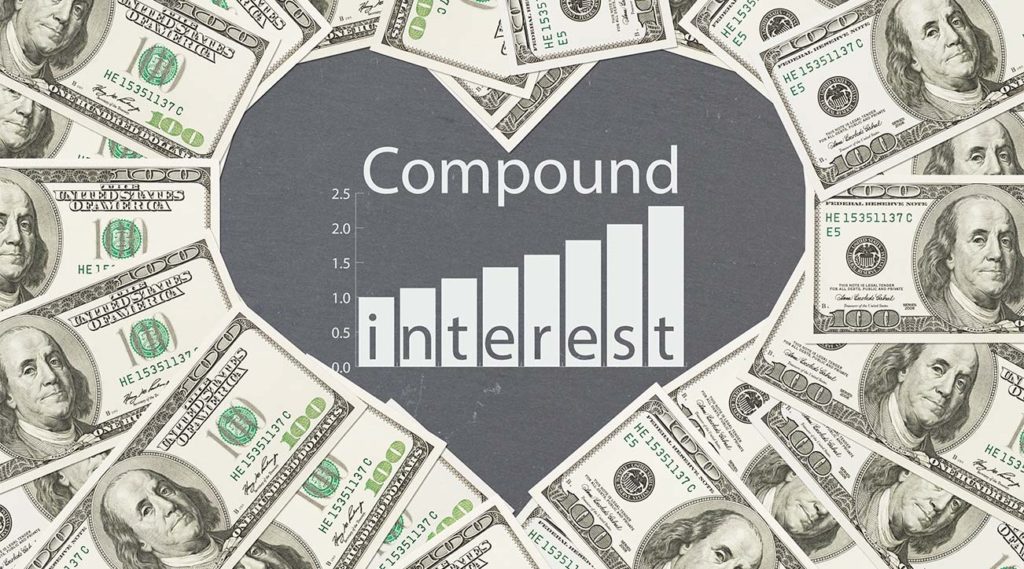UPDATED: May 19, 2022

Compound interest is the eight wonder of the world. He who understands it, earns it; he who doesn't, pays for it.
- Albert Einstein
Most people are familiar with the concept of a snowball rolling down the hill and getting bigger and bigger as it hoovers up snow. That same concept can be applied to growing money that is salted away in a savings account, invested in stocks, or retirement accounts. Compounding boosts the growth of that initial deposit, or what people call “interest on interest” or the “future value of money.”
Compound interest occurs when interest gets added to the principal amount invested or borrowed, and then the interest rate applies to the new, larger principal. Over time it can lead to exponential growth.
Table of Contents
How Does Compound Interest Work?
Say $1,000 was deposited into a savings account with a 10% interest rate (an unrealistically high rate, but helpful for examples) that compounds annually. After one year, the account will have $1,100—the initial $1,000 in principal plus $100 in interest. That $100 is "simple" interest—interest based only on the principal amount invested.
The magic begins if the saver is disciplined and lets the funds get bigger. At the end of the second year, the account will have grown to $1,210—the $1,100 from the previous year plus $110 in added interest (10% of $1,100).
Instead of calculating interest based only on the original principal, compounding interest calculates the annual interest based on the principal plus any previous interest earned on that principal.
By the end of the 10th year, the savings will be $2,594, more than double the initial savings (without adding any additional money after the initial investment). The growth was due to compound interest.
What Is the Formula for Compound Interest?
A = P(1+r/n)nt
- P is the principal (the starting amount)
- r is the annual interest rate, which is written as a decimal
- n is the number of times the interest compounds each year
- t is the time, or total number of years
- A is the total amount you will wind up with at the end of the time frame
Fortunately, there are many online tools to calculate how much interest will accrue and how compounding can impact a savings or an investment account. However, the formula can offer insight into how compounding works.
For example, people usually know the amount they can save (P) and the time frame (t). As a result, there are two variables to consider as different options for saving the money—the interest rate (r) and compounding frequency (n).
The impact of a higher or lower interest rate is straightforward. A higher rate means more interest gets added each cycle.
Similarly, the more often interest compounds, the faster the growth. For example, here's how different frequencies impact the growth of $1,000 with a 10% interest rate.
| Compounds Daily | Compounds Monthly | Compounds Annually | |
| After One Year | $1,105 | $1,105 | $1,100 |
| After Two Years | $1,221 | $1,220 | $1,210 |
| After Five Years | $1,161 | $1,645 | $1,611 |
| After 10 years | $2,718 | $2,707 | $2,594 |
Rule of 72
A popular shortcut to calculate how fast savings will grow over time is by employing the rule of 72. The rule of 72 is a simple way to determine how long an investment will take to double given a fixed annual rate of interest.
By dividing 72 by the annual rate of return, investors obtain a rough estimate of how many years it will take for the initial investment to double in value. Thus, if a savings account’s annual rate of return is 8%, it will take nine years for the funds to double.
The Magic of Compound Interest & Time
There are two ways to obtain ‘compound interest’ from a stock portfolio —capital gains and dividends (note that both capital gains and dividends must be reinvested to gain added compound value).
If the dividends are reinvested, it helps to boost long-term returns because of the power of compounding. The dividends enable more shares to be bought over time, which increases the dividend in the next distribution, and leads to the purchases of even more shares. That’s a positive virtuous circle.
To provide an illustration of the power of time and compounding, consider the investment decisions of twin sisters, Sue and Mary, who are both saving for retirement.
The Power of Time
Sue started investing at age 30 and invested $2,000 each year for 10 years. After that, she stopped investing completely.
However, Mary procrastinated until she turned 40 to start investing for her retirement. She invested $2,000 each year until she turned 65 for a total of 25 years.
Mary invested for 15 more years than her sister. Assuming they both earned an 7% annual rate of return, which one would end up with the larger age nest egg by 65?
The answer is Sue. She only put in $20,000, but her account grew to $160,474 by retirement. Mary, who invested a total of $50,000, ended up with $135,353. The difference is due to time and compounding. Sue began earlier and allowed more time for compounding to work its magic.
Warren Buffett and the Power of Compounding
Warren Buffett learned about the power of compound interest at a young age and has benefited from it to become a successful investor. From an early age, Mr. Buffett has understood that building wealth depends not only on how much your money grows, but also on how long it grows.
He has offered this advice about investing: “The money is made in investments by investing and by owning good companies for long periods of time. If they [investors] buy good companies, buy them over time, they’re going to do fine 10, 20, 30 years from now.”
Around the age of 10, Buffett read a book about how to make $1,000 and intuitively grasped the importance of time. In five years, $1,000 earning 10% would be worth more than $1,600; 10 years of 10% growth would turn it into nearly $2,600 and in 50 years, it would compound to almost $117,400.
How Does Compound Interest Impact Debt?
Overall, compounding is a positive force to help savings grow more quickly than it would with simple interest. However, it can also work against a person who borrows money.
Many credit cards compound interest daily on average daily balances. While the calculation is complicated, the bottom line isn't: Compound interest on credit cards adds to the debt for consumers who carry over a balance from month to month.
The high interest rate and daily compounding are two reasons why paying off credit card debt can be difficult—and why it is best to pay credit card balances in full each month. That way the account is charged zero interest and helps to avoid compounding interest on the debt.
Some types of loans, such as federal student loans and mortgages, generally don't have daily compounding interest. As long as the monthly payment covers the accrued interest, then the interest doesn't compound.
However, if the monthly payment doesn't cover the monthly interest, then the overall loan balance may grow—what's known as negative amortization. If the unpaid interest is added to the principal balance of the loan, then the interest rate may apply to that larger balance (in other words, the interest compounds).
Therefore, when applying for any type of loan, especially a large loan, it is important to understand how interest accumulates and when it compounds.







jlgrove says
As a small business owner, I use this article to get young employees to start contributing to our retirement plan. Thank you for an easy to understand explanation.
Rodriquez says
This helped a lot thank you propercents.com